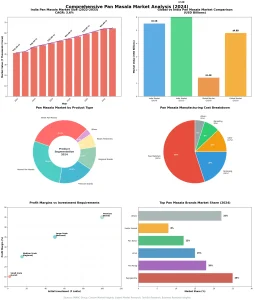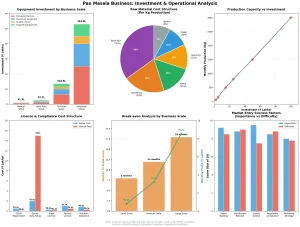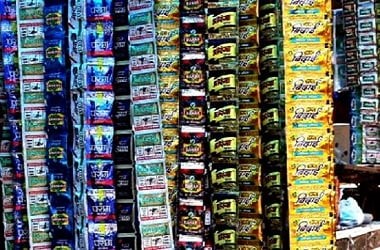It can be initiated from anywhere across the mainland of India. Possibly the greatest advantage that this business can boast of is that a considerable percentage of Indian customers would consume pan masala regardless of their probable disadvantages. It is reported that some 80% of Indians have a taste for it, making it one of the highest-selling products in the market.
Scour any street corner, and it will definitely not have to look for a pan-masala selling shop. Its importance is further proved as one cannot even come by a food shop across every three corners without one being available. The increasing number of tobacco and pan masala business shops almost reaches a million now.
Market analysis and planning are indispensable to both understand market dynamics and generate reports, analytical data, and insights capable of competing with such players as Rajnigandha to establish a pan masala business. Starting any pan masala requires the raw materials, machinery, as well as licenses. At NPCS, we provide all necessary information to ensure a smooth and successful launch of your pan masala business.
Visit this Page for more information: Start a Business in Tobacco and Pan Masala Industry
Table of Contents
ToggleMarket Evaluation for the Pan Masala Business
In 2021, the Indian pan masala market reached a value of INR 41,821 Crore and is projected to grow at a CAGR of 3.88% from 2022 to 2027, reaching INR 53,081.5 Crore by 2027. The market has been buoyant to all challenges, inclusive of COVID-19. All the reports deal with the direct and indirect impact of the pandemic, crucially for those entrepreneurs who plan to enter the pan masala.

Market Size & Growth Analysis (2024-2033)
India Pan Masala Market Overview
The Indian pan masala market has reached ₹46,682 crores in 2024 and is projected to grow at a CAGR of 3.6%, reaching ₹64,446 crores by 2033. This substantial growth is driven by:
Consistent consumer demand across urban and rural markets
Rising disposable income in Tier-2 and Tier-3 cities
Product innovation with premium and flavored variants
Strong distribution networks reaching over 8 million retail outlets
Global Market Comparison
India Market: $5.52 billion (2024) → $6.95 billion (2030)
Global Market: $1.42 billion (2024) → $4.8 billion (2033)
India’s Dominance: Controls 75%+ of global pan masala consumption
Market Segmentation Analysis
Sweet Pan Masala: 32% market share (fastest growing segment)
Normal Pan Masala: 28% market share (traditional segment)
Premium Brands: 18% market share (high-margin segment)
Regional Brands: 12% market share (local focus)
Others: 10% market share
Source: IMARC Group, TechSci Research, Custom Market Insights
Raw Materials Required for the Business of Pan Masala
The manufacturing business of pan masalas consists of manufactures categorized under two heads:
- Normal Pan Masala
- Sweet Pan Masala
If you are planning on making sweet pan masala, you will have to get a different set of ingredients. However, the core raw materials required to start any pan masala are:
- Black cutch (Katha)
- Cardamom
- Betel nut
- Flavoring substances
- Natural aromatic substances
With increasing demand, additional ingredients are added to the range of finished pan masala . These are chocolate, sugar-coated fennel, saffron, and gulkand. This increases the value of the products in the market and is a good strategy to attract more customers.
Related Business Plan: Pan Masala
Machinery Required for the Pan Masala Business
However, investment is essential in this business. But, for small-scale entrepreneurs, they could either go for the manual machines for packaging to cut down initial expenses.
Types of Machines for a Pan Masala Business
- Manual Packaging Machine – Most suitable for small pan masala setups.
- Semi-Automatic Machine – This machine can produce more of the product within limited manpower.
- Fully Automatic Machine – For large-scale pan masala manufacturing establishments.
A small setup also needs a packaging machine. You can buy this machine for as low as a few lakh rupees, making it the most important investment in pan masala.
Related Feasibility Study Reports: Pan Masala, Tobacco, Zarda & Kimam

Licenses and Registrations Required for the Pan Masala Business
Starting the pan masala requires obtaining various registrations and approvals.
- Excise Duty Registration – Registration with the Central Excise Authority is mandatory.
- Monthly Excise Duty Payment – Excise duty must be paid in advance based on the manufacturing capacity.
- Licenses for Pan Masala Business:
- 2008 Rules for Packaging and Labelling of Tobacco Products.
- Food Adulteration Prevention Act.
- Food Safety and Standards (Packaging & Labelling) Regulations, 2011.
For your pan masala, it is essential to comply with all licensing requirements to avoid legal complications.
Read Similar Articles: TOBACCO AND PAN MASALA
Land and Location for the Pan Masala
The space requirement depends on the scale of the pan masala.
- Small-Scale Business – Minimal space (a few hundred square feet) required.
- Large-Scale Business – Manufacturing and storage require 1000 to 2000 square feet.
An ideal location would facilitate the smooth running and better reach of your pan masala into the market.
Related Book: Manufacture of Pan Masala, Tobacco and Tobacco Products. 2nd Revised Edition
Challenges in the Pan Masala Business
Though the market is nonetheless growing, pan masala is hit with many challenges:
- Health Awareness – Awareness of the ill effects of pan masala is making a dent in demand marginally.
- Product Innovation – Productions of pan masala are experimenting with the introduction of unique flavors and attractive packaging in sustaining market growth.
- Government Regulations – Enormous hindrances in their regulatory protocols against operations and advertisement of the pan masala business.
- Competitive Market – Global leaders such as Rajnigandha and Vimal own the Pan Masala industry, making it almost impossible to enter it.
New entrants must focus on innovative marketing, quality products, and compliance with regulations to survive.
Youtube Link: Pan Masala Sada | Meetha & Zarda | Mrket Survey | cum Detailed Techno Economic Feasibility Report
Success Stories & Industry Leaders
Billionaire Success Stories
Case Study 1: DS Group (Rajnigandha Empire)
Founded: 1929 by Dharampal Gulati
Current Valuation: ₹3,200+ crores annual revenue
Success Factors:
Premium positioning and brand building
Strategic celebrity endorsements
International expansion (present in 60+ countries)
Key Learning: Focus on quality and consistent branding
Case Study 2: Manikchand Group (RMD Pan Masala)
Founded: 1960s by Rasiklal Manikchand Dhariwal
Current Revenue: ₹8,000+ crores annually
Achievements:
Daughter’s 21st birthday gift: ₹5 crore Maybach (2004)
Lavish family celebrations with Bollywood attendance
Success Strategy: Market penetration in rural areas
Case Study 3: Regional Success – Kanpur Pan Masala Hub
Market Concentration: 40% of India’s pan masala production
Annual Turnover: ₹15,000+ crores from Kanpur region alone
Employment: Direct employment to 50,000+ people
Export Contribution: 25% of India’s pan masala exports
Small-Scale Success Examples
Local Entrepreneur (Uttar Pradesh)
Initial Investment: ₹8 lakhs (2019)
Current Monthly Revenue: ₹12 lakhs
Growth Strategy: Focus on local distribution and quality
Key Success Factor: Strong retailer relationships
Regional Brand (Gujarat)
Started: ₹15 lakhs investment (2020)
Achievement: ₹2.5 crore annual turnover within 3 years
Strategy: Organic ingredients and premium positioning
Conclusion
Starting a pan masala business takes substantial planning, market research, and licensing. The entrepreneur faces numerous challenges related to health issues, chances of adulteration, and legal barriers. Any lack of concern regarding product quality could lead to the cancellation of the license or closure of the concern.
NPCS provides detailed reports on all sectors, including the pan masala one. Our expert team compiled thorough industry insights for an entrepreneur to land on a good decision. If you have any doubts regarding the pan masala plan, feel free to get in touch with us for expert help.
Frequently Asked Questions
Business Setup & Investment
Q1: What is the minimum investment required to start a pan masala business?
A: You can start with ₹2-5 lakhs for a micro-scale operation. For commercial viability, expect ₹10-25 lakhs investment.
Q2: What are the most profitable product categories in pan masala business?
A: Premium and sweet pan masala offer 30-45% profit margins, while standard varieties provide 15-25% margins.
Q3: How long does it take to break even in pan masala business?
A: Break-even typically occurs in 6-8 months for small scale, 8-12 months for medium scale operations.
Manufacturing & Equipment
Q4: What is the shelf life of pan masala products?
A: Properly manufactured pan masala has 12-18 months shelf life with appropriate packaging.
Q5: What equipment is essential for a 500kg monthly production unit?
A: Semi-automatic packing machine (₹1.75 lakhs), mixing equipment (₹80,000), weighing systems (₹30,000), and sealing machines (₹60,000).
Q6: What are the raw material costs per kg of production?
A: Raw material costs range from ₹400-600 per kg, depending on quality and supplier agreements.
Legal & Compliance
Q7: Is FSSAI registration mandatory for pan masala business?
A: Yes, FSSAI registration is mandatory. Choose appropriate category based on annual turnover.
Q8: What is the current excise duty rate on pan masala?
A: Central excise duty is approximately ₹4,170 per kg, with additional state taxes varying by location.
Q9: Can I advertise pan masala products directly?
A: Direct advertising is restricted. Most companies use surrogate advertising through elaichi/cardamom branding.
Market & Sales
Q10: What is the current market size of pan masala industry in India?
A: The Indian pan masala market is valued at ₹46,682 crores (2024) and growing at 3.6% CAGR.
Q11: Which states have the highest consumption of pan masala?
A: Uttar Pradesh, Bihar, Rajasthan, and Madhya Pradesh account for 60% of national consumption.
Q12: What is the typical retailer margin in pan masala business?
A: Retailers typically earn 8-15% margins, while distributors earn 4-8% margins.
Competition & Strategy
Q13: Who are the leading players in pan masala industry?
A: Top players include DS Group (Rajnigandha), Manikchand Group (RMD), Pan Bahar, and Vimal.
Q14: How can small players compete with established brands?
A: Focus on regional markets, quality products, competitive pricing, and strong distributor relationships.
Q15: What are the key success factors in pan masala business?
A: Quality consistency, strong distribution network, effective marketing, regulatory compliance, and brand building.
Financial Planning
Q16: What is the working capital requirement for a medium-scale unit?
A: Working capital needs are typically 2-3 months of operating expenses, around ₹15-25 lakhs for medium-scale operations.
Q17: What are the major cost components in pan masala manufacturing?
A: Raw materials (55%), packaging (20%), labor (12%), marketing (8%), overheads (5%).
Q18: What financing options are available for pan masala business?
A: MSME loans, equipment financing, working capital limits, and government schemes like PMEGP.
Export Opportunities
Q19: Can I export pan masala products?
A: Yes, India exports to 25+ countries. Major markets include UAE, Canada, UK, and Southeast Asian countries.
Q20: What are the export profit margins?
A: Export margins range from 35-50%, higher than domestic sales due to premium pricing.







Sir pan masala ka bisniss start karne me kitna khrch ayega